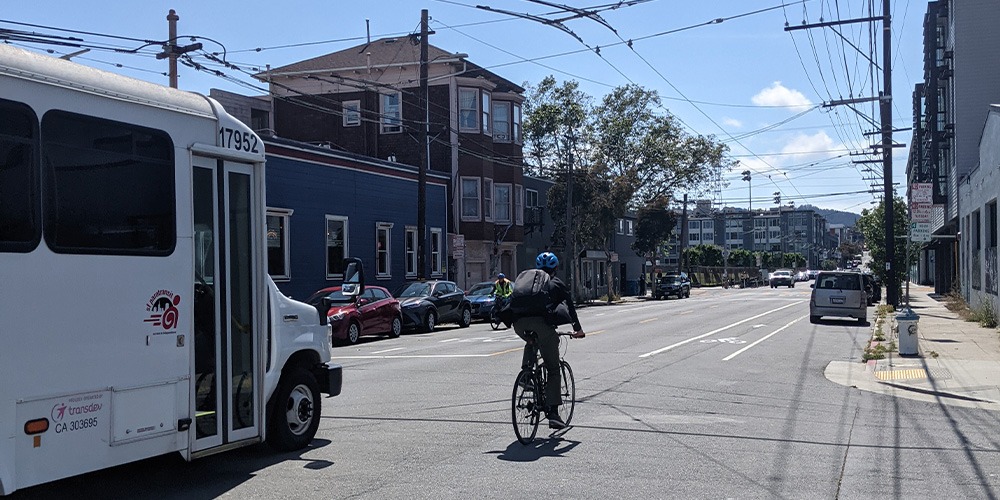As the San Francisco Municipal Transportation Agency (SFMTA)’s 17th Street Quick-Build Project nears its final approval this fall, neighborhood advocates and a subset of the street’s small businesses conflict over the repurposing of parking spaces for protected bike lanes.
17th Street, which connects San Francisco’s eastern and western areas, is recognized by SFMTA and the San Francisco Bicycle Coalition as one of the city’s key bike corridors. Cyclists traveling between the Lower Haight, the Mission, Potrero Hill, and Mission Bay rely on this passage.

photo courtesy of Google Maps / Graphic by Andrew Chou-Belden
Quick-Builds are an expedited, lower-cost set of projects meant to improve streets in San Francisco’s Vision Zero High Injury Network. The 17th Street Quick-Build, which targets 17th Street from Potrero Avenue to Pennsylvania Avenue, would upgrade existing paint-only bike lanes into Class IV bikeways. Certain sections of 17th Street would be reconfigured so that vertical posts or parking spaces are placed between bike lanes and moving traffic, which creates a safety buffer for cyclists and easier parking access for drivers. The project would also add stop signs, insert protected corners, mark unmarked crosswalks and shift colored curbs. Research conducted by New York City’s Department of Transportation shows that protected bike lanes increase safety for all road users by shortening pedestrian crossing distances, reducing traffic weaving and allowing pedestrians and cyclists to cross before cars are permitted to turn.

photo courtesy of SFMTA

photo courtesy of SFMTA
Thijs Simonian ’24 is a former member of SFMTA’s Youth Transportation Advisory Board who frequently bikes on 17th Street. “17th Street is still not safe in many regards,” he said. “On a lot of the streets, you’re right next to the cars, and the roads aren’t very wide, so it sometimes feels like the cars get pretty close. There’s also lots of driveways and gas stations.” Simonian explained it is nerve-wracking to both bike and drive on 17th Street.
From 2017 to 2022, SFMTA reported 3,601 injuries to people using bicycles, scooters, and other stand-up devices. During that same time frame, the project’s targeted section of 17th Street, between Potrero and Pennsylvania Avenues, saw 31 reported traffic collisions, more than half of which involved vehicles striking cyclists.
The general sentiment among transportation advocates is that street safety reforms should be preemptive, rather than prompted by injuries and casualties.
The need for a shift towards sustainable transportation modes like biking is particularly pressing in San Francisco, where the city government has declared a climate emergency and transportation (predominantly composed of private, gas-powered vehicles) accounts for 44% of all emissions. “Roadway safety and comfort continue to be leading barriers to offering bicycling and walking as a viable option for more people,” reads SFMTA’s projects webpage. “The project is motivated by the city’s goals related to mode shift towards more sustainable and climate-friendly transportation options, detailed in San Francisco’s Climate Action Plan and the SFMTA’s Strategic Plan and Transit First policy.”
After a year of community outreach, design revisions and public hearings, the 17th Street Quick-Build remains highly controversial. The main opposition to the project comes from a subsect of small businesses who are opposed to the project’s removal of some 129 parking spaces.
Bottom of the Hill, a well-known small concert venue on 17th Street, has led much of the opposition to the Quick-Build on the grounds that the project will eliminate parking options for its performers, who often arrive in large vehicles and trailers. In an October 2022 article published in the Potrero View, Bottom of the Hill co-owner Lynn Schwarz was quoted as saying, “The day that we are not able to provide parking to our bands, we will have to stop booking shows… With all our touring bands, which keep us in business, we are contractually obligated to ensure parking, and the only other option… is to rent parking from the City at $310 a pop for 120 feet. This price tag is not sustainable on a nightly basis for any small business.”
“The side streets are pull-in spaces, where anything with a trailer cannot park, so without our parking along 17th Street… we would be out of options of how to get bands situated,” said Schwarz, who has stressed that she herself is a cyclist concerned with safety. “While we understand that loss of parking is a natural consequence of development, and that free parking is not our birthright… the wholesale loss of parking along 17th Street as described by the plans we’ve seen will be a killer for us and many other local businesses.”
San Francisco Flower Mart, a wholesale flower business, has contended that the loss of parking spaces will affect its employees, who arrive in the early morning to prepare the facility and park in the surrounding area. Notably, Flower Mart has a newly constructed two-story parking garage with 150 spots and an additional 25 spots for box trucks. Other businesses on 17th Street, including Arch Art Supplies, have also publicly opposed the project.
Proponents of the 17th Street Quick-Build range from ordinary residents to transportation advocates, businesses and other establishments on 17th Street. The Safer 17th Street Initiative, an advocacy campaign led by transportation advocates, has been endorsed by 19 organizations and local establishments to date, including Kaiser Permanente, Blu Dot, and California College of the Arts. Addressing the loss of parking spaces, Luke Bornheimer, a longtime San Francisco resident and self-identifying sustainable transportation advocate, noted that San Francisco’s transportation system has historically “prioritized, optimized, and subsidized” private vehicles. “In order to make our city more… sustainable and our streets more livable and people-oriented, we will have to make them less optimized and subsidized for private automobiles,” he said.
While some stakeholders perceive the 17th Street Quick-Build as a negative change, others feel like there is not enough being done to increase San Francisco’s transportation safety and sustainability. Currently, the city’s transportation reform projects typically happen on individual blocks or streets, usually as a result of volunteer advocacy or concentrated efforts by elected officials. The City of San Francisco and SFMTA currently have no public-facing plans for a connected, protected network of bike lanes. Borhheimer alleges that this lack of cohesion, combined with opposition from residents and businesses, can result in “watered-down” reforms that are missing key blocks or sections.
To sustainable transportation advocates like Bornheimer, the 17th Street Quick-Build Project is not an isolated campaign, but rather part of a much broader movement to make San Francisco streets safer and more sustainable. “A connected, protected network of bike lanes will help people, many of whom want to shift trips from cars to active transportation,” said Bornheimer. “This will reduce car traffic for people who need to drive while reducing noise and air pollution, improving public health, and making San Francisco… more livable and sustainable.”
Research by the Urban Institute shows that cities are increasingly investing in safer bike infrastructure. SFMTA is currently conducting outreach for its Active Communities Plan, which is set to be drafted in February 2024 and will support “a citywide shift to active transportation” guided by Vision Zero and San Francisco’s Climate Action Plan.
After considering the sustainability and safety benefits of protected bike lanes and hearing 17th Street businesses’ concerns about the 17th Street Quick-Build, SFMTA’s Board of Directors will hold a public hearing and vote on the project’s final approval on October 17th at the earliest. If the project is approved, construction will take place in 2024.






